Introduction
Understanding the early signs of Autism Spectrum Disorder (ASD) is crucial for timely intervention and improved developmental outcomes. Diagnostic tools that capture the full spectrum of ASD behaviors are essential in this process. Innovations like the SenseToKnow app leverage technology to analyze a child's gaze patterns, facial expressions, and motor skills, providing a streamlined and engaging diagnostic process.
Early and accurate screening is significant as it prevents potential disabilities from becoming entrenched. The US Preventive Services Task Force emphasizes the importance of early identification and intervention, particularly in speech and language delays, which are associated with increased risks of learning and social challenges. Embracing technological advancements and evidence-based screening recommendations can change the lives of children touched by ASD.
Importance of Early Screening for Autism Spectrum Disorder (ASD)
Recognizing the signs of Autism Spectrum Disorder (ASD) is a foundational step towards ensuring timely intervention, which is proven to markedly enhance developmental outcomes. As ASD presents a diverse array of behaviors, it's imperative to have diagnostic tools that capture its full spectrum. Innovations like the SenseToKnow app are revolutionizing the early detection landscape by analyzing a young individual's gaze patterns, facial expressions, head movements, blink rate, and even motor skills through an engaging bubble-popping game. These behaviors are crucial indicators, as motor skill delays are among the earliest markers of ASD.
This technology utilizes a tablet's sensors and artificial intelligence to evaluate the responses of an individual in their early years, streamlining the diagnostic process without the requirement for calibration or specialist equipment. Using AutMedAI, a machine learning model that employs 28 parameters to detect patterns of ASD, researchers have achieved an 80% success rate in identifying individuals with autism. Such tools highlight the importance of timely and accurate screening to facilitate support at a time when the brain's plasticity is at its peak, thus preventing the entrenchment of potential disabilities.
The US Preventive Services Task Force (USPSTF) also acknowledges the complexity of clinical decisions and the role of technology in improving diagnostic accuracy. By prioritizing 'primary' speech and language delays and disorders in young individuals, the USPSTF aims at timely identification and intervention, which is crucial considering the link of these delays with heightened risks of learning, literacy, and social difficulties. As we move forward, embracing these technological advancements and evidence-based screening recommendations will be instrumental in changing the trajectory of young lives touched by ASD.
Common Screening Tools for Toddlers
Screening tools designed for toddlers play a significant role in the identification of Autism Spectrum Disorder (ASD). These instruments, designed to observe and assess the nuances of a young person's social behavior, communication abilities, and interactive patterns, are crucial in the initial stages of diagnosis. Their implementation by health professionals is crucial, as they yield insights that can prompt further, more in-depth evaluations for ASD if necessary.
Ongoing initiatives in the early identification of individuals with autism emphasize the potential for effective treatment of the disorder, with the general agreement being that the sooner the intervention, the better the outlook for the development of those affected. Groundbreaking research from Duke University has introduced innovative methods such as eye-tracking technologies that analyze children's reactions to visual stimuli. These advancements boost the potential for a more nuanced understanding of a developmental disorder, possibly paving the way for diagnoses that could occur significantly earlier than the current norm.
The urgency for these diagnostic advancements is highlighted by organizations like The Autism Community in Action (TACA), which emphasizes the crucial nature of timely and accurate diagnosis. With the right tools in place, the often protracted journey to an autism diagnosis could be reduced from years to mere weeks, offering immense relief to families seeking clarity and support. This is especially pertinent for families with an increased genetic predisposition to ASD, where the risk is substantially higher.
The US Preventive Services Task Force (USPSTF) continues to emphasize the importance of evidence-based recommendations for preventive care services, which include the early screening for speech and language delays. These preventive measures are especially targeted towards individuals without pre-existing conditions known to impact speech or language development, advocating for a personalized approach to healthcare that takes into account the unique circumstances of each patient.
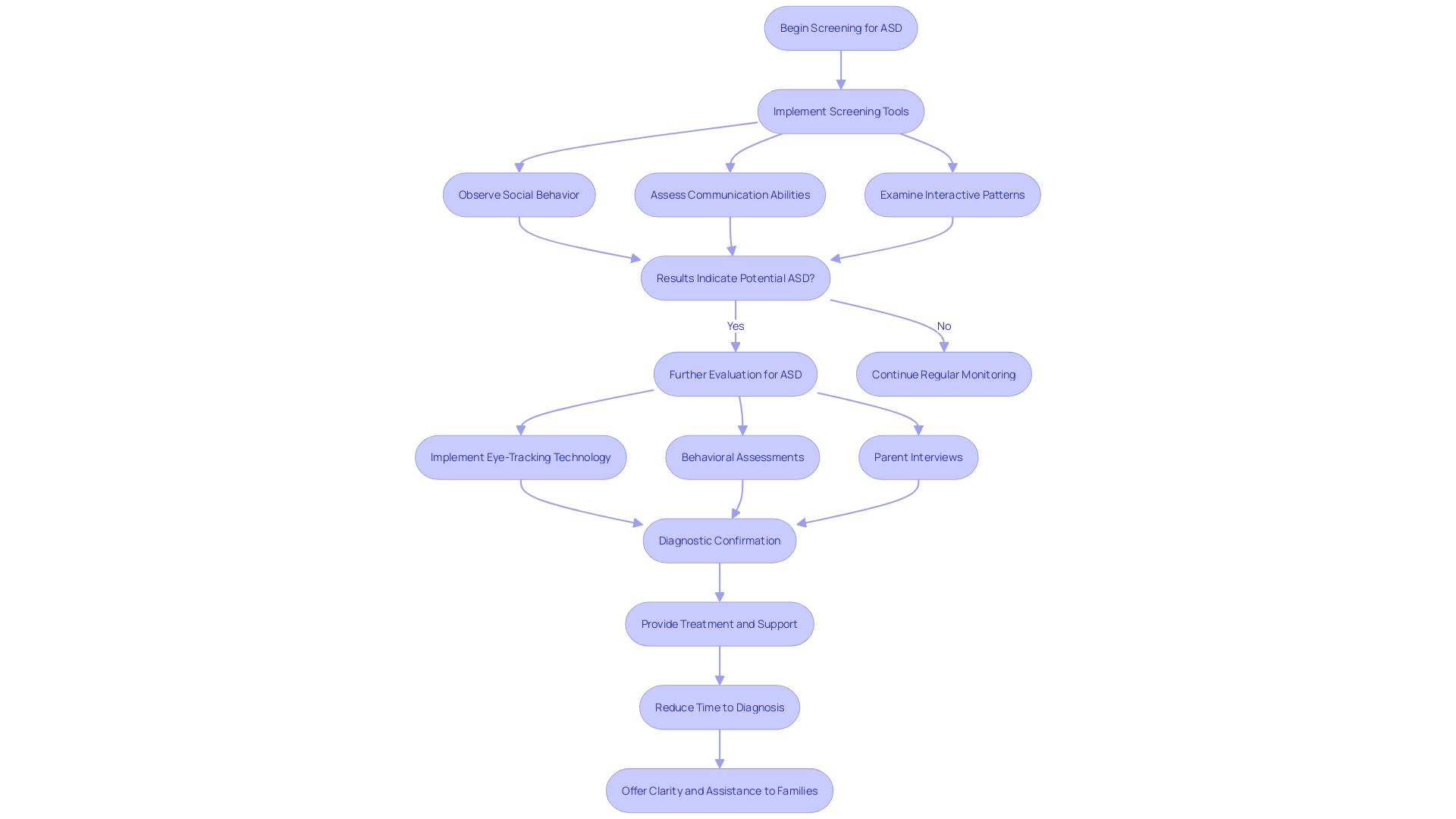
Modified Checklist for Autism in Toddlers (M-CHAT)
The journey toward comprehending a youngster's distinct growth often starts with tools like the Modified Checklist for Autism in Toddlers (M-CHAT). This questionnaire, completed by those who are most familiar with the individual, their parents or caregivers, delves into the nuances of behavior and developmental milestones. It's a crucial first pass at identifying signs that may suggest Autism Spectrum Disorder (ASD), thereby catalyzing a pathway towards more comprehensive evaluation by healthcare experts.
In the quest for detection of ASD, advancements in research have led to innovative methods such as combining observational protocols of parent-child interactions with cutting-edge machine learning techniques. For instance, by analyzing how an individual and their caregiver build and play with blocks together, valuable insights into social and cognitive development can surface. When paired with an attention-enhanced deep learning framework, these interactions can reveal patterns indicative of ASD, potentially offering a more precise tool for early identification than existing screening methods.
In a world where internet searches on pediatric health are common, with a staggering 90% conducted by family members, it's imperative to acknowledge that not all information is created equal. Challenges like functional literacy, where symptom spelling errors occur, or critical literacy, where families may follow inaccurate health information, can misguide parents. Moreover, interactive literacy, the ability to apply information, can be a hurdle. Despite these challenges, the aim of ensuring a fair competition, as advocated by Dr. David (Dan) R. Offord, highlights the significance of supporting children and young individuals with disabilities to guarantee equal opportunities for development and engagement in society.
The landscape of autism research and intervention is ever-evolving. Traditional intensive behavioral interventions are continually weighed against more flexible, developmentally-informed approaches. This dynamic field reflects the diverse needs and strengths of individuals on the autism spectrum and their families, underscoring the necessity for resources that adapt to their unique journeys.
As clinicians draw from the latest research to inform their practices, they rely on a variety of study designs ranging from randomized controlled trials to quasi-experimental studies. The transition towards more rigorous scientific approaches strengthens the confidence in interventions selected for each individual, aiming to provide the best possible support for both individuals and their caregivers on their journey to fulfillment and well-being.

Screening Tool for Autism in Toddlers and Young Children (STAT)
In the pursuit of early detection of autism spectrum disorder (ASD), the Screening Tool for Autism in Toddlers and Young Children (STAT) has proven to be a valuable instrument. This tool facilitates an interactive assessment between an individual in their early years and a healthcare professional who has received specialized training. During the STAT evaluation, the professional observes and gauges the individual's communicative behaviors and social interactions. Recent advancements in the field have emphasized the significance of primary speech and language development monitoring, particularly in individuals under the age of five who show no other symptoms of developmental delays.
Research has been leaning towards innovative methods for ASD screening, including technology-assisted tools that analyze eye movements, facial expressions, and even motor skills during game-based interactions. One such advancement is an app that utilizes tablet sensors to characterize an individual's response patterns, utilizing artificial intelligence to predict autism likelihood. These technological advancements are augmenting traditional tools like STAT, providing a more comprehensive evaluation of ASD signs.
The US Preventive Services Task Force (USPSTF) recognizes the complexity of clinical decision-making and the necessity of individualizing care based on more than just clinical evidence. Therefore, the incorporation of both traditional tools such as STAT and emerging technologies demonstrates a dynamic healthcare system, adjusting to the intricacies of ASD detection at an initial stage and the unique requirements of every individual.
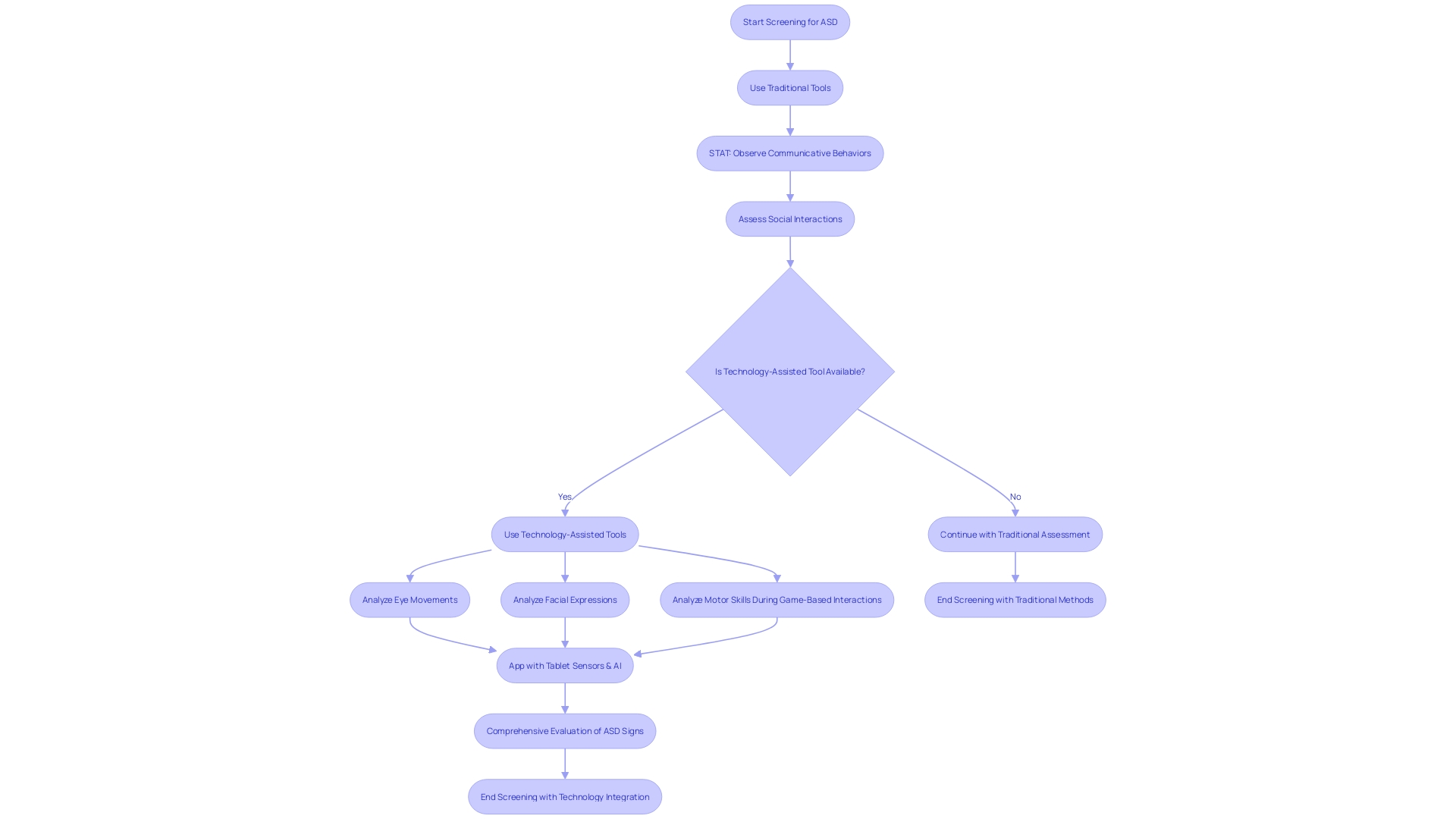
Early Screening of Autistic Traits Questionnaire (ESAT)
Autism spectrum disorder (ASD) presents with diverse symptoms and behaviors, affecting social interaction, communication, and learning. Identifying signs at an initial stage is crucial for timely intervention. The Early Screening of Autistic Traits Questionnaire (ESAT) is a proactive step toward this goal. A tool completed by parents, the ESAT casts a net for early indicators of ASD by examining a young individual's social engagement, communicative skills, and repetitive behaviors. With the American Academy of Pediatrics' guidance, there's a growing emphasis on incorporating autism screening into routine pediatric visits, despite a reported gap in implementation. Comprehensive efforts, including the development of innovative detection tools and service delivery models, are underway to embed these screenings seamlessly into healthcare practices. The ESAT contributes to these efforts, paving the way for young individuals to receive support and services at the earliest possible stage, which can significantly influence their developmental trajectory.
Childhood Autism Spectrum Test (CAST) and Other Tools
Autism Spectrum Disorder (ASD) diagnosis involves nuanced and multifaceted assessments, reflecting the complex nature of the condition. While tools like the Childhood Autism Spectrum Test (CAST), designed for individuals aged 4 to 11, offer valuable insights into an individual's social interactions and behaviors through questionnaires, it is one of many methods healthcare professionals utilize. In accordance with the guidelines of the US Preventive Services Task Force (USPSTF), which prioritize individualized care without strict financial considerations, healthcare professionals can choose from a wide range of screening instruments designed to meet the specific requirements of each young person. The USPSTF also acknowledges the importance of addressing health disparities and supports efforts to mitigate the negative consequences of systemic inequities on health outcomes. This is particularly pertinent considering that speech and language delays—markers that may indicate ASD—can contribute significantly to learning challenges and social issues, potentially persisting into adulthood.
Recent advancements in technology, like the SenseToKnow app created by researchers at Duke University, signify a significant step forward in screening for individuals with a certain developmental condition. Through the analysis of the responses to visual stimuli, such as eye movements and facial expressions, the app employs AI to forecast the probability of an ASD diagnosis. This innovative approach captures a broad spectrum of behaviors, offering a more comprehensive and accurate reflection of the disorder's variability. Geraldine Dawson, a leading figure in autism research, emphasizes that the diversity of behaviors associated with autism necessitates tools that can accurately represent this complexity. As screening methodologies evolve, they increasingly cater to the individualized needs of children, aligning with the USPSTF's approach to patient-centered care.
Key Characteristics and Effectiveness of Each Tool
Healthcare professionals use a variety of screening tools to identify signs of Autism Spectrum Disorder (ASD) at the initial stages, each with its specific strengths. These tools, while not diagnostic, play a crucial role as preliminary indicators signaling the need for further assessments. The US Preventive Services Task Force (USPSTF) underscores the importance of evidence-based recommendations for preventive services, such as these screenings, which do not factor in service costs but focus on benefit-harm balance. Such screenings are crucial, especially considering that speech and language delays, often initial signs of ASD, can have lasting impacts on learning, literacy, and social behaviors.
Recent advancements in the detection of autism at a young age include innovative tools like Sense to know, which utilizes AI to analyze a child's responses to stimuli for indications of the condition. With new strategies being implemented in routine healthcare, screening is becoming more embedded in pediatric care, aiming to connect families to support services at the earliest. Despite guidelines from the American Academy of Pediatrics, only a minority of pediatricians systematically screen for autism, highlighting the gap between science and practice.
According to the CDC, ASD may affect as many as 1 in 36 individuals, making screening and diagnosis critical. The DSM-5 outlines specific behavioral criteria for ASD diagnosis, including persistent challenges in social interaction and repetitive patterns of behavior. It's essential to recognize that while ASD's exact cause remains unknown, it is attributed to neurological differences, not vaccines, parenting styles, or nutrition.
Healthcare professionals are trained to interpret screening results, taking into account not just the evidence of clinical benefits and harms but also individual patient needs and broader social factors, such as systemic and structural inequities.
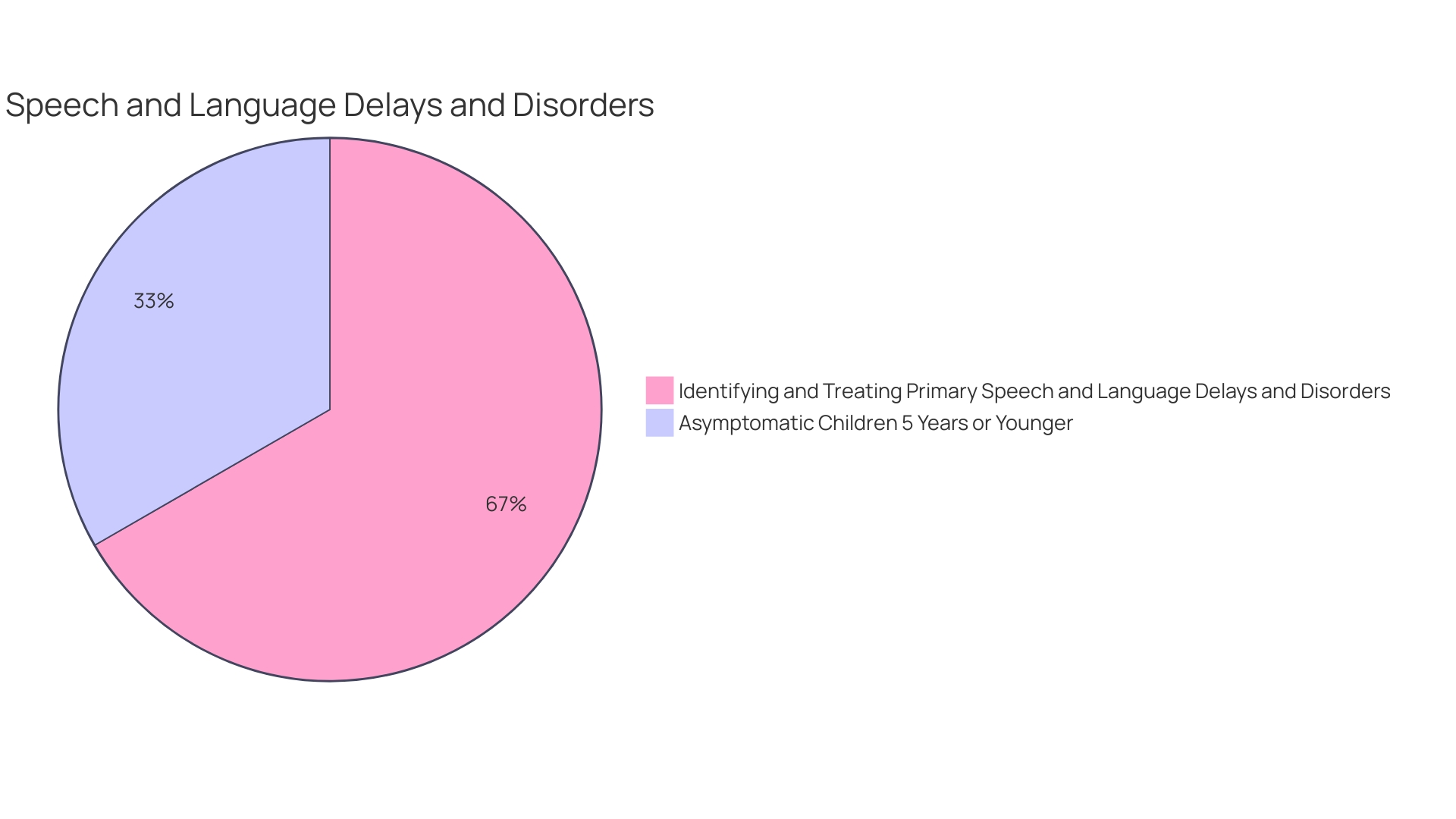
Sensitivity and Specificity of Screening Tools
Autism Spectrum Disorder (ASD) presents with a complex array of behaviors and symptoms, making the screening and identification process multifaceted. Screening tools designed to detect ASD are tuned for sensitivity and specificity; sensitivity measures the tool's capacity to correctly identify those with ASD, while specificity assesses the ability to exclude those without the disorder. A comprehensive diagnostic approach typically includes both parental accounts of a child's developmental history and a professional's evaluation of the child's behavior, aligning with standards set by the DSM-5.
Recent innovations in ASD screening tools, such as SenseToKnow, leverage advanced technology including AI and sensor data from tablets to evaluate a broad spectrum of behaviors, from eye movement responses to interactive games assessing motor skills. These tools are part of a crucial shift towards earlier and more precise diagnosis, as emphasized by organizations like The Autism Community in Action, which supports families and underscores the benefits of intervention. Ongoing research continues to enrich the methods available, providing healthcare professionals with increasingly sophisticated instruments for timely and reliable ASD detection.
Administration and Accessibility of Screening Tools
Readily available screening tools for Autism Spectrum Disorder (ASD) are now accessible in various environments such as healthcare facilities, schools, and intervention programs. These tools are crucial for the early detection of ASD signs, which can have a significant impact on a youngster's developmental path. The US Preventive Services Task Force (USPSTF) underscores the necessity of screening services that are beneficial without causing harm, emphasizing that these decisions should be customized to each individual's circumstances. This aligns with the push for equitable healthcare practices that address the challenges of systemic and structural biases.
Innovations in screening technologies, such as the SenseToKnow app developed by Duke University researchers, are revolutionizing ASD diagnosis. By analyzing a young individual's reactions to visual stimuli through a tablet's camera and employing artificial intelligence, this app can predict the likelihood of an ASD diagnosis. This method captures a spectrum of behaviors, from eye movement patterns to facial expressions, without requiring any specialized equipment.
Furthermore, early identification of speech and language delays, which can be precursors to learning and social challenges, is crucial. Observational studies have revealed that such delays can increase the risk of learning disabilities and may contribute to ongoing social and behavioral problems. The emphasis on primary speech and language delays guarantees that individuals who may not yet exhibit apparent symptoms are nonetheless evaluated and assisted. This proactive approach reflects a commitment to promoting positive mental health outcomes and supporting the engagement of young individuals in the essential aspects of their lives.
Next Steps After a Positive Screening Result
When an individual's ASD screening indicates potential concerns, it's imperative to seek a comprehensive evaluation. This typically involves a thorough review by a team of specialists, such as neurodevelopmental pediatricians and pediatric neurologists, who use a combination of parental insights and clinical observations. With a set of standardized criteria provided by the DSM-5, professionals can determine a diagnosis of ASD. However, it's critical to note that no single assessment tool is definitive. A referral to a specialist may follow, enhancing the accuracy of the diagnosis through more specialized assessments. Upon diagnosis, timely intervention can be customized to the specific needs of the individual, providing the optimal chance for support and growth.
Recent reports have spotlighted the overwhelming demand for autism assessments, with waiting lists growing exponentially post-Covid-19, underscoring the necessity for early and efficient diagnosis. The initiative's discoveries underscore the significant influence of timely assistance on a young one's education and well-being. Furthermore, the present scenario indicates that numerous youngsters are excluded from receiving essential support due to delays in obtaining a medical diagnosis. This situation creates an urgent call for systems that can expedite the diagnostic process and offer immediate assistance to those in need without the prerequisite of a formal diagnosis.
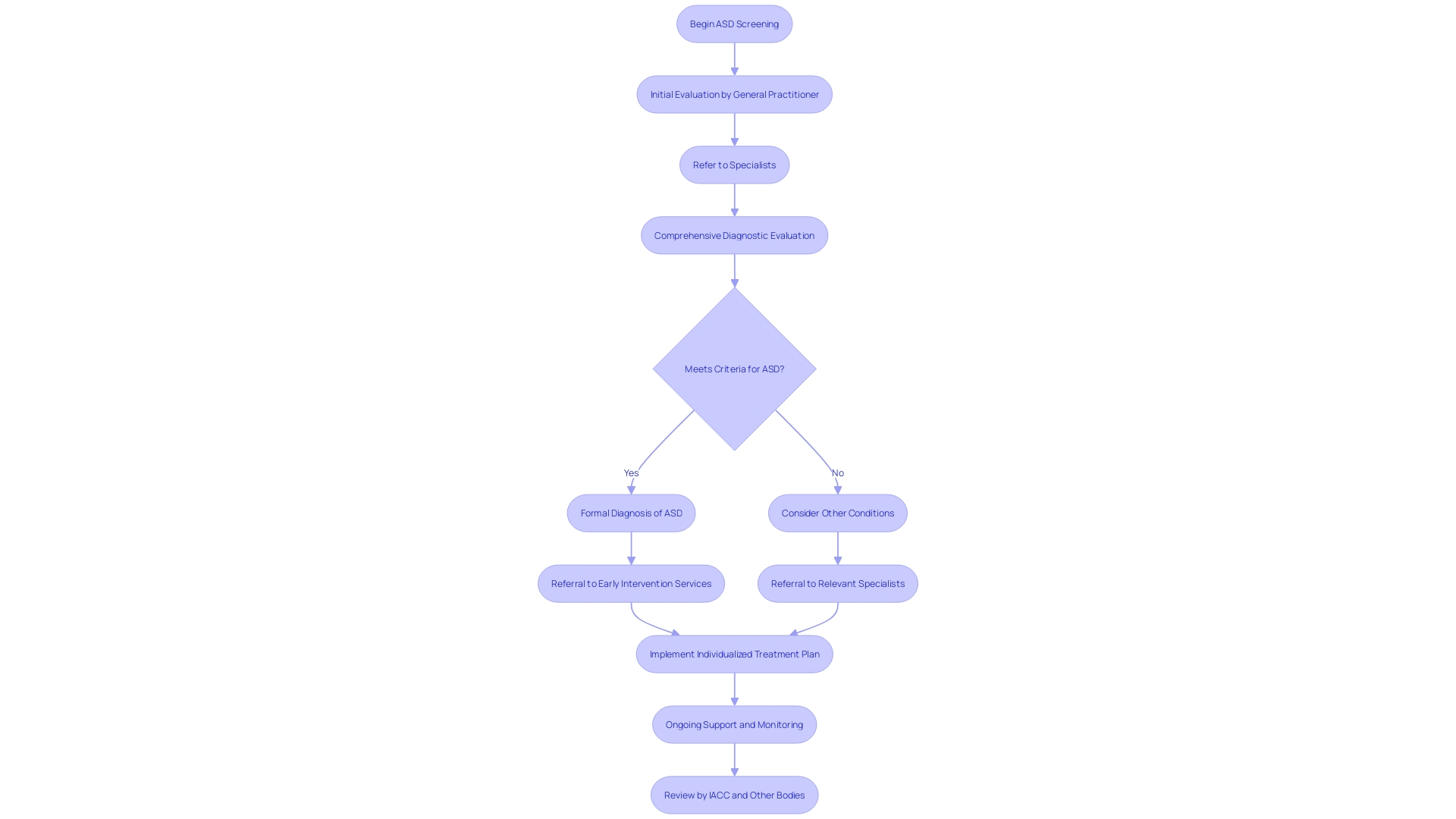
The Role of Healthcare Professionals and Multidisciplinary Teams
Healthcare professionals, including pediatricians, psychologists, and developmental specialists, play a crucial role in evaluating individuals with ASD. They work with diverse teams to provide a comprehensive evaluation and develop individualized care plans for every young individual. However, studies reveal that gaps in professionals' knowledge about ASD can lead to misdiagnosis and inappropriate treatment, which significantly impacts the well-being of individuals with autism. The necessity for healthcare providers to have enhanced training developed in collaboration with autistic adults is underscored to minimize processing demands and optimize patient engagement.
Autism diagnosis relies on careful observation of a young individual's behavior by professionals and detailed descriptions from parents or caregivers. Standardized criteria from the DSM-5 aid in making an informed ASD diagnosis, emphasizing that no single tool is definitive for diagnosis. When necessary, primary care providers may refer families to specialists, such as neurodevelopmental pediatricians or neurologists who specialize in the evaluation of children, for a more in-depth evaluation.
The urgency of early and accurate diagnosis is highlighted by organizations like The Autism Community in Action (TACA), which supports thousands of families. Starting interventions such as behavioral therapy at the earliest can significantly enhance outcomes for children with ASD. New advancements in diagnostic technologies aim to shorten the typically lengthy process of obtaining an ASD diagnosis, which can extend over several years.
Moreover, the US Preventive Services Task Force (USPSTF) advocates for evidence-based recommendations to improve national health outcomes, not influenced by service costs. Recognizing the health risks associated with speech and language delays, the USPSTF is committed to addressing health disparities influenced by systemic and structural inequities.
The Interagency Autism Coordinating Committee (IACC) serves as a federal advisory body, striving to accelerate progress in research and services for individuals on the spectrum through collaboration with various stakeholders, including individuals with autism, family members, and public advocates. The work of this committee reflects the collective knowledge of its members and serves as an important resource for the community impacted by the condition.
Recognizing the important contribution of healthcare professionals in the ASD diagnostic process, there is a shared demand for ongoing research, enhanced training, and innovative tools to aid in the early detection and intervention of individuals on the spectrum, ultimately resulting in an improved quality of life for them.
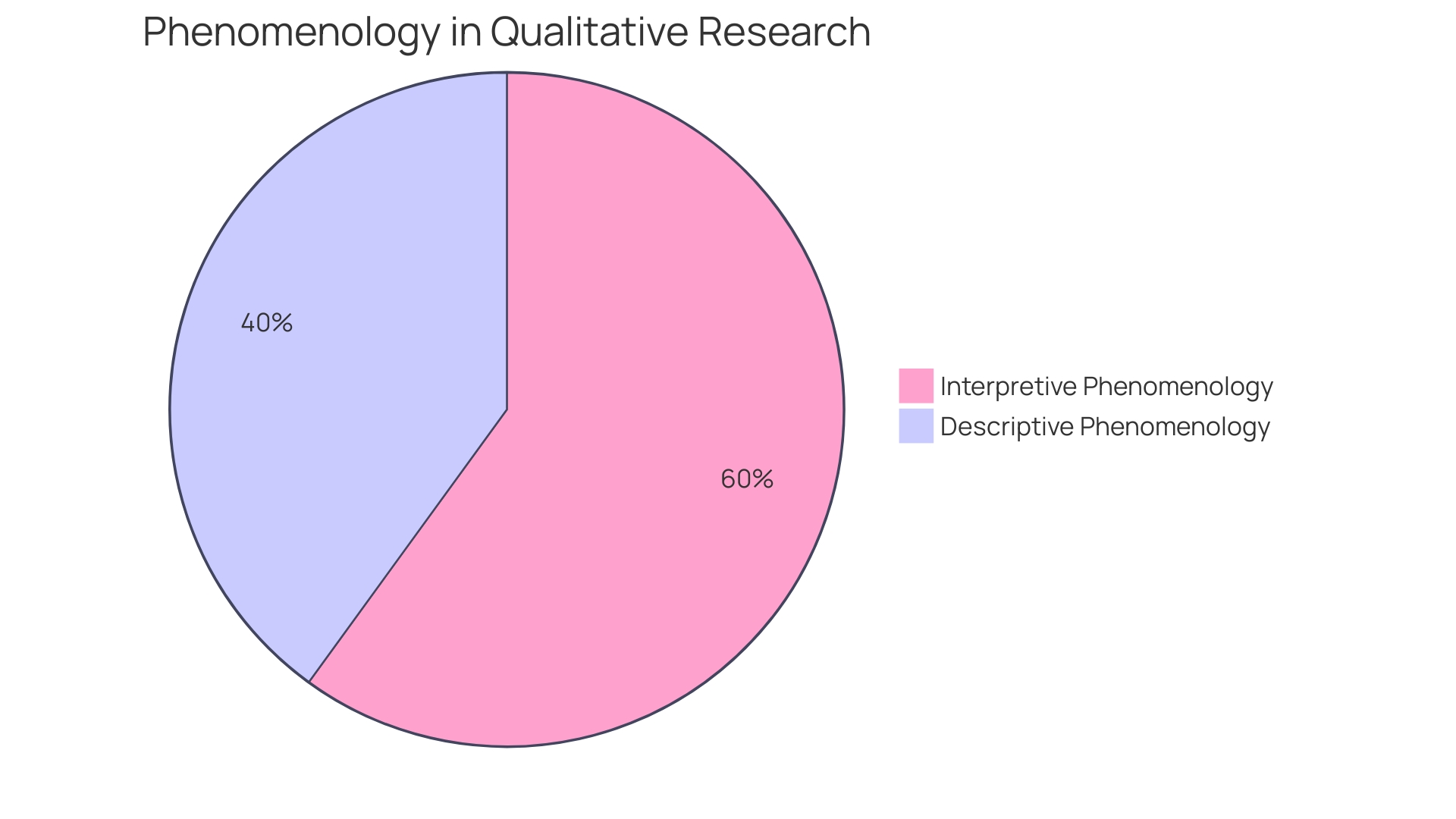
Addressing Racial Disparities and Inequities in ASD Diagnosis
Understanding autism spectrum disorder (ASD) is vital, especially considering its occurrence across diverse ethnic, racial, and socioeconomic groups. ASD's unique challenges in communication and behavior can impact individuals' functioning in various life areas, such as school and work, leading to a negative societal view of those affected and their families.
Efforts to eliminate racial disparities in ASD diagnosis are critical, as research indicates certain racial and ethnic groups encounter barriers to timely and accurate diagnosis. Efforts are being made to improve awareness and access to screening tools, guaranteeing that evaluations are culturally sensitive and inclusive for all individuals.
Advancements in technology, such as the SenseToKnow app, are contributing to early ASD detection by capturing and analyzing behavioral responses to stimuli, offering a potential pathway to reduce diagnostic disparities. Studies like CHARGE and ReCHARGE also shed light on how neighborhood characteristics and socioeconomic factors might influence child development and access to care.
Significant progress in the study of ASD, including the efforts of Professor Brian Boyd at the University of North Carolina at Chapel Hill, are addressing racial and gender disparities in ASD diagnosis. The IACC's role in coordinating research and services for individuals with ASD reflects a commitment to inclusivity and equity in addressing the needs of the autism community.
Moreover, the neurodiversity-affirming movement emphasizes person-centered care that respects autistic individuals' diverse experiences and needs. By understanding the global impact of ASD, as highlighted in research from Africa, we can better appreciate the necessity of culturally responsive approaches to caring for individuals with autism spectrum disorder.
Statistics from KFF's 2023 Racism, Discrimination, and Health Survey highlight the broader context of health inequities, indicating the urgency of addressing these issues within healthcare systems, including the realm of ASD diagnosis and treatment. The survey underscores the link between discrimination and poorer health outcomes, reinforcing the need for equity-focused interventions.
Sources
Autism Spectrum Disorder (ASD) is a complex condition that presents persistent differences in communication, social interaction, and behavior across various environments. ASD's spectrum nature means it affects individuals differently and to varying degrees. The American Psychiatric Association's Diagnostic and Statistical Manual (DSM-5) outlines specific criteria for diagnosis, which include restricted and repetitive patterns of behavior and activities, and challenges in social communication. Early and accurate diagnosis is crucial, enabling access to resources and support that can enhance the quality of life. As per the Centers for Disease Control and Prevention (CDC), the prevalence of ASD may be as high as 1 in 36 individuals, underscoring the need for effective screening tools.
The process of diagnosing ASD involves meticulous observation and documentation of a child's behavior, which can be an administrative burden for healthcare providers. Pediatricians often dedicate over 50% of their time to tasks like writing medical visit notes. To tackle this, innovative solutions such as Summer Health offer text-based pediatric care, streamlining follow-up communications and care plans for parents, thus reducing the administrative load on healthcare professionals.
Despite misunderstandings, there is no one identified reason for the condition. Differences in brain structure or function have been observed in individuals with ASD, and while genetics and heredity may play a role, factors like parenting styles, nutrition, or vaccines do not lead to the development of this condition. This dispels myths and focuses attention on valid scientific research and understanding.
The Autism Community in Action (TACA) highlights that treatable autism's first step is an accurate diagnosis. TACA's programs support families, emphasizing that intervention such as behavioral therapy can significantly improve outcomes. NeuroQure, a biotech startup, is breaking ground with gene therapy for neurocognitive disorders, having licensed a patent portfolio to develop precise diagnostic tools for ASD. These advancements aim to shorten the journey to diagnosis, which is vital for early intervention.
To enhance research and services for individuals with autism spectrum disorder, the Interagency Autism Coordinating Committee (IACC) promotes coordination among federal agencies and collaborates with the autistic community, incorporating a range of perspectives and expertise. The US Preventive Services Task Force (USPSTF) also plays a role in healthcare by recommending preventive services based on evidence, without consideration of cost, acknowledging that race, ethnicity, and gender—while social constructs—can be health risk predictors.
In the context of speech and language development, the USPSTF focuses on primary delays and disorders in asymptomatic children, recognizing the broader impacts these can have on learning and social behavior. This nuanced approach to health services and research conveys a commitment to addressing autism's multifaceted nature, ensuring that individuals on the spectrum receive the personalized care and support they deserve.
Conclusion
In conclusion, early screening for Autism Spectrum Disorder (ASD) is crucial for timely intervention and improved developmental outcomes. Diagnostic tools that capture the full spectrum of ASD behaviors are essential in this process. Innovations like the SenseToKnow app, which analyzes gaze patterns, facial expressions, and motor skills, provide a streamlined and engaging diagnostic process.
Embracing technological advancements and evidence-based screening recommendations can change the lives of children touched by ASD.
Healthcare professionals play a vital role in the ASD evaluation process, working with multidisciplinary teams to deliver thorough assessments and personalized care strategies. It is important for professionals to have enhanced training developed in collaboration with autistic adults to minimize processing demands and optimize patient engagement.
Accessible screening tools for ASD are now available in diverse environments, ensuring the early detection of signs that can significantly influence a child's developmental trajectory. Efforts are being made to eliminate racial disparities in ASD diagnosis by enhancing awareness, access to screening tools, and culturally sensitive evaluations.
It is crucial to seek a comprehensive evaluation when a child's ASD screening indicates potential concerns. A diagnosis of ASD is not based on a single assessment tool but requires a thorough review by specialists. Early intervention can then be tailored to the child's specific needs, offering the best opportunity for support and development.
Overall, by embracing early screening, supporting healthcare professionals, addressing disparities, and providing accessible tools, we can empower parents to navigate the challenges of ASD and ensure the well-being of their children. Together, we can make a positive impact on the lives of individuals on the autism spectrum.
Try the SenseToKnow app for a streamlined and engaging diagnostic process.




